Magazine (firearms)

A magazine is an ammunition storage and feeding device within or attached to a repeating firearm. Magazines can be removable (detachable) or integral to the firearm. The magazine functions by moving the cartridges stored in the magazine into a position where they may be loaded into the chamber by the action of the firearm. The detachable magazine is often referred to as a clip, although this is technically inaccurate.[1][2][3]
Magazines come in many shapes and sizes, from those of bolt action express rifles that hold only a few rounds to those for machine guns that can hold as many as one hundred rounds. Various jurisdictions ban high-capacity magazines.
Nomenclature
With the increased use of semi-automatic and automatic firearms, the detachable box magazine became increasingly common. Soon after the adoption of the M1911 pistol, the term "magazine" was settled on by the military and firearms experts, though the term "clip" is often used in its place (though only for detachable magazines, never fixed).[4][5][6] The defining difference between clips and magazines is the presence of a feed mechanism in a magazine, typically a spring-loaded follower, which a clip lacks. Use of the term "clip" to refer to detachable magazines is a point of strong disagreement.[2][7][8][9]
The Merriam-Webster dictionary defines a clip as "a device to hold cartridges for charging the magazines of some rifles; also: a magazine from which ammunition is fed into the chamber of a firearm".[10]
History
The earliest firearms were loaded with loose powder and a lead ball, and to fire more than a single shot without reloading required multiple barrels, such as pepper-box guns and double-barreled shotguns, or multiple chambers, such as in revolvers. Both of these add bulk and weight over a single barrel and a single chamber, however, and many attempts were made to get multiple shots from a single loading of a single barrel through the use of superposed loads.[11] Breech loading designs such as the needle gun, and paper cartridges sped the loading process, but successful repeating mechanisms did not appear until self-contained cartridges were developed.
Gravity magazines

The earliest magazines appeared not on firearms, but rather on air guns. Without the need for powder, the magazine contained only the balls; the power was provided by high pressure air supplied by an air reservoir in the butt of the gun. The Girandoni Air Rifle was fairly typical of the repeating air rifles of 1780. The Girandoni held 22 balls in a gravity fed tubular magazine, located beside and parallel to the barrel. Due to the use of a large air reservoir, the rifle could fire all the shots in its magazine before the reservoir was depleted enough to require recharging. Firing was accomplished by raising the muzzle of the gun to allow the balls to fall to the rear of the magazine, sliding a ball from the magazine into the barrel with a sliding breech-block, then cocking the hammer (which was connected to a valve) and firing.[12]
The Fusil Gras mle 1874 rifle is a bolt-action breech-loading single shot rifle. In its original configuration had no magazine. However, in 1883, a ten round gravity fed magazine was developed for the Gras. This magazine allowed the rifle produced a high rate of fire, but were not issued in significant numbers.
Tubular magazines
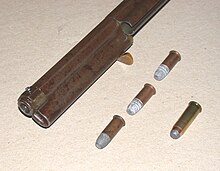

The first successful repeater was the Volcanic Rifle which used a hollow bullet with the base filled with powder and primer (an early form of caseless ammunition) fed into the chamber from a spring-loaded tube called a magazine. It was named after a building or room used to store ammunition. The anemic power of the Rocket Ball ammunition used in the Volcanic doomed it to limited popularity.
The Henry repeating rifle is a lever-action, breech-loading, tubular magazine fed rifle, and was an improved version of the earlier Volcanic rifle. Designed by Benjamin Tyler Henry in 1860, it was one of the first firearms to use self-contained metallic cartridges. The Henry was introduced in the early 1860s and produced through 1866 in the United States by the New Haven Arms Company. It was adopted in small quantities by the Union in the Civil War and favored for its greater firepower than the standard issue carbine. Many later found their way West and was famed both for its use at the Battle of the Little Bighorn, and being the basis for the iconic Winchester rifle which are still made to this day.[13] The Henry and Winchester rifles would go on to see service with a number of militaries including Turkey. Switzerland and Italy adopted similar designs.[13]
The first magazine-fed firearm to achieve widespread success was the Spencer repeating rifle, which saw service in the American Civil War. The Spencer used a tubular magazine located in the butt of the gun instead of under the barrel and it used new rimfire metallic cartridges. The Spencer was successful but the rimfire ammunition did occasionally ignite in the magazine tube and destroy the magazine. It could also injure the user.
The new bolt action rifle began to gain favor with militaries in the 1880s and were often equipped with tubular magazines. The Mauser Model 1871 was originally a single-shot action that added a tubular magazine in its 1884 update. The Norwegian Jarmann M1884 was adopted in 1884 and also used a tubular magazine. The French Lebel Model 1886 rifle also used 8-round tube-fed magazine.[14]
Gatling gun feeding mechanisms

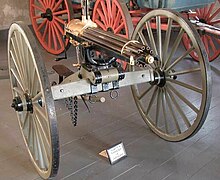

Internal box magazines

Number 1 & 2: Mosin–Nagant
Number 3 & 4 : Lebel
Number 5 & 6 : Gewehr 1888
Number 7 & 8 : Mannlicher M1888
Number 9 & 10 : Lee–Metford
Number 11 & 12 : Dutch-Mannlicher M1895
Number 13 & 14 : Mauser M1893
Number 15 : Krag–Jørgensen
Number 16 : Schmidt–Rubin M1889
The military cartridge was evolving as the magazine rifle evolved. Cartridges evolved from large-bore cartridges (.40 caliber/10 mm and larger) to smaller bores that fired lighter, higher-velocity bullets and incorporated new smokeless propellants. The Lebel Model 1886 rifle was the first rifle and cartridge to be designed for use with smokeless powder and used an 8 mm wadcutter-shaped bullet that was drawn from a tubular magazine. This would later become a problem when the Lebel's ammunition was updated to use a more aerodynamic pointed bullet. Modifications had to be made to the centerfire case to prevent the spitzer point from igniting the primer of the next cartridge inline in the magazine.[15]
However, the solution had already been developed, when James Paris Lee patented a box magazine which held rounds stacked vertically in 1879 and 1882 and it was first adopted by Austria in the form of an 11mm straight-pull bolt-action rifle, the Mannlicher M1886. It also used a cartridge clip which held 5 rounds ready to load into the magazine.[15][16]
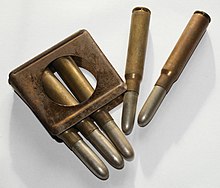
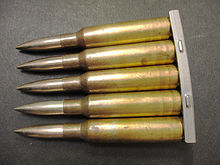
The bolt-action Krag–Jørgensen rifle, designed in Norway in 1886, used a unique rotary magazine that was built into the receiver. Like Lee's box magazine, the rotary magazine held the rounds side-by-side, rather than end-to-end. Like most rotary magazines, it was loaded through a loading gate one round at a time, this one located on the side of the receiver. While reliable, the Krag–Jørgensen's magazine was expensive to produce and slow to reload. It was adopted by only three countries, Denmark in 1889, the United States in 1892,[17] and Norway in 1894.
Clip-fed revolution
A clip (called chargers by the British) is a device that is used to store multiple rounds of ammunition together as a unit, ready for insertion into the magazine or cylinder of a firearm. This speeds up the process of loading and reloading the firearm as several rounds can be loaded at once, rather than one round being loaded at a time. Several different types of clips exist, most of which are made of inexpensive metal stampings that are designed to be disposable, though they are often re-used.
In 1888 the Germans developed the Model 1888 Commission Rifle with a 5-round en-bloc clip-fed internal box magazine.[18] Mauser would continue to make improved models from 1889 through 1893 in various calibers were adopted by various militaries at this time.[15] In 1890 the French adopted the 8mm Lebel Berthier rifles with 3-round internal magazines, fed from en-bloc clips; the empty clips were pushed from the bottom of the action by the insertion of a loaded clip from the top.[19][20]
In the late 1800s there were many short-lived designs, such as the M1895 Lee Navy and Gewehr 1888, eventually replaced by the M1903 Springfield rifle and Gewehr 98 respectively. The Russian Mosin–Nagant, adopted in 1891, was an exception. It was not revolutionary; it was a bolt-action rifle, used a small-bore smokeless powder cartridge, and a fixed box magazine loaded from the top with stripper clips, all of which were features that were used in earlier military rifles. What made the Nagant stand out was that it combined all the earlier features in a form that was to last virtually unchanged from its issue by Russia in 1894 through World War II and with its sniper rifle variants still in use today.
An interesting feature of many late 19th- and early 20th-century bolt-action rifles was the magazine cut-off, sometimes called a feed interrupter. This was a mechanical device that prevented the rifle from loading a round from the magazine, requiring the shooter to manually load each individual round as he fired, saving the rounds in the magazine for short periods of rapid fire when ordered to use them. Most military authorities that specified them assumed that their riflemen would waste ammunition indiscriminately if allowed to load from the magazine all the time.[21] By the middle of World War I, most manufacturers deleted this feature to save costs and manufacturing time; it is also likely that battlefield experience had proven the futility of this philosophy.
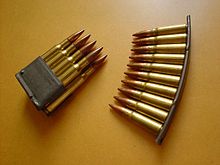
One of the last new clip-fed, fixed-magazine rifles widely adopted that wasn't a modification of an earlier rifle was the M1 Garand rifle. The first semi-automatic rifle that was issued in large numbers to the infantry, the Garand was fed by a special eight-round en-bloc clip. The clip itself was inserted into the rifle's magazine during loading, where it was locked in place. The rounds were fed directly from the clip, with a spring-loaded follower in the rifle pushing the rounds up into feeding position. When empty, the bolt would lock open, and a spring would automatically eject the empty clip, leaving the rifle ready to be reloaded. The M14 rifle, which was based on incremental changes to the Garand action, switched to a detachable box magazine.[22] However, the M14 could also be loaded via 5-round stripper-clips.[23]
The Soviet SKS carbine, which entered service in 1945, was something of a stopgap between the semi-automatic service rifles being developed in the period leading up to World War II, and the new assault rifle developed by the Germans. The SKS used a fixed magazine, holding ten rounds and fed by a conventional stripper clip. It was a modification of the earlier AVS-36 rifle, shortened and chambered for the new reduced power 7.62×39mm cartridge. It was rendered obsolete for military use almost immediately by the 1947 introduction of the magazine-fed AK-47 assault rifle, though it remained in service for many years in Soviet Bloc nations alongside the AK-47. The detachable magazine quickly came to dominate post-war military rifle designs.[24]
Detachable box magazines

M1 Garand 8-round en-bloc clip,
M14 20-round magazine,
M16 STANAG 20- and 30-round magazines
The Lee–Metford rifle, developed in 1888, was one of the first rifles to use detachable box magazine.[25] However, the first completely modern removable box magazine was patented in 1908 by Arthur Savage for the Savage Model 99.[26] Other guns did not adopt all of its features until his patent expired in 1942: It has shoulders to retain cartridges when it is removed from the rifle. It operates reliably with cartridges of different lengths. It is insertable and removable at any time with any number of cartridges. These features allow the operator to reload the gun infrequently, carry magazines rather than loose cartridges, and to easily change the types of cartridges in the field. The magazine is assembled from inexpensive stamped sheet metal. It also includes a crucial safety feature for hunting dangerous game: when empty the follower[27] stops the bolt from engaging the chamber, informing the operator that the gun is empty before any attempt to fire.
The first successful semi-automatic pistol was the Borchardt C-93 (1893) and incorporated detachable box magazines. Nearly all subsequent semiautomatic pistol designs adopted detachable box magazines.
The Swiss Army evaluated the Luger pistol using a detachable box magazine in 7.65×21mm Parabellum and adopted it in 1900 as its standard side arm. The Luger pistol was accepted by the Imperial German Navy in 1904. This version is known as Pistole 04. In 1908 the German Army adopted the Luger to replace the Reichsrevolver in front-line service. The Pistole 08 (or P.08) was chambered in 9×19mm Parabellum. The P.08 was the usual side arm for German Army personnel in both world wars.
The M1911 semi-automatic pistol set the standard for most modern handguns and likewise the mechanics of the handgun magazine. In most handguns the magazine follower engages a slide-stop to hold the slide back and keep the firearm out of battery when the magazine is empty and all rounds fired. Upon inserting a loaded magazine, the user depresses the slide stop, throwing the slide forward, stripping a round from the top of the magazine stack and chambering it. In single-action pistols this action keeps the hammer cocked back as the new round is chambered, keeping the gun ready to begin firing again.
During World War One, detachable box magazines found favor, being used in all manner of firearms; such as pistols, light-machine guns, submachine-guns, semi-automatic and automatic rifles. However, after the War to End All Wars, military planners failed to recognize the importance of automatic rifles and detachable box magazine concept, and instead maintained their traditional views and preference for clip-fed bolt-action rifles. As a result, many promising new automatic rifle designs that used detachable box magazines were abandoned.
As World War II loomed, most of the world's major powers began to develop submachine guns fed by 20- to 40-round detachable box magazines. However, of the major powers, only the United States would adopt a general-issue semi-automatic rifle that used detachable box magazines; the M1 Carbine with its 15-round magazines. As the war progressed the Germans would develop the Sturmgewehr 44 assault rifle concept with its 30-round detachable magazine. After WWII, automatic weapons using detachable box magazines would be developed and used by all of the world's armies. Today, detachable box magazines are the norm and they are so widely used that they are simply referred to as "magazines" or "mags" for short.
Function and types


All cartridge-based single-barrel firearms designed to fire more than a single shot without reloading require some form of magazine designed to store and feed cartridges to the firearm's action. Magazines come in many shapes and sizes, with the most common type in modern firearms being the detachable box type. Most magazines designed for use with a reciprocating bolt firearm (tube fed firearms being the exception) make use of a set of feed lips which stop the vertical motion of the cartridges out of the magazine but allow one cartridge at a time to be pushed forward (stripped) out of the feed lips by the firearm's bolt into the chamber. Some form of spring and follower combination is almost always used to feed cartridges to the lips which can be located either in the magazine (most removable box magazines) or built into the firearm (fixed box magazines). There are also two distinct styles to feed lips. In a single-feed design the top cartridge touches both lips and is commonly used in single-column box magazines. A dual- or alternating-feed magazine consists of a wider set of lips so that the second cartridge in line forces the top cartridge against one lip. This design has proven more resistant to jamming in use with dual-column magazines.[28] Some magazine types are strongly associated with certain firearm types, such as the fixed "tubular" magazine found on most lever-action rifles and pump-action shotguns. A firearm using detachable magazines may accept a variety of types of magazine, such as the Thompson submachine gun, which would accept box or drum magazines. Some types of firearm, such as the M249 and other squad automatic weapons, can feed from both magazines and belts.
Tubular
Many of the first repeating rifles, particularly lever-action rifles, used magazines that store cartridges end-to-end inside of a spring-loaded tube typically running parallel to the barrel, or in the buttstock. Tubular magazines are also commonly used in pump-action shotguns and .22 caliber rimfire rifles.
Box
The most popular type of magazine in modern rifles and handguns, a box magazine stores cartridges in a column, either one above the other or staggered zigzag fashion. This zigzag stack is often identified as a double-column or double-stack since a single staggered column is actually two side-by-side vertical columns offset by half of the diameter of a round. As the firearm cycles, cartridges are moved to the top of the magazine by a follower driven by spring compression to either a single feed position or side-by-side feed positions. Box magazines may be integral to the firearm or removable.
- An internal box or fixed magazine (also known as a blind box magazine when lacking a floorplate) is built into the firearm and is not easily removable. This type of magazine is found most often on bolt-action rifles. An internal box magazine is usually charged through the action, one round at a time. Military rifles often use stripper clips or chargers permitting multiple rounds, commonly 5 or 10 at a time, to be loaded at once. Some internal box magazines use en-bloc clips that are loaded into the magazine with the ammunition and that are ejected from the firearm when empty.
- A detachable box magazine is a self-contained mechanism capable of being loaded or unloaded while detached from the host firearm. They are attached via a slot in the firearm receiver, usually below the action but occasionally to the side (Sten, FG42, Johnson LMG) or on top (Madsen machine gun, Bren gun, FN P90). When the magazine is empty, it can be detached from the firearm and replaced by another full magazine. This significantly speeds the process of reloading, allowing the operator quick access to ammunition. This type of magazine may be straight or curved, the curve being necessary if the rifle uses rimmed ammunition or ammunition with a tapered case. Detachable box magazines may be metal or plastic. The plastic magazines are sometimes partially transparent so the operator can easily check the remaining ammunition. Box magazines are often affixed to each other with clips, tape, straps, or built-in studs to facilitate faster reloading: aka jungle style.
There are, however, exceptions to these rules. The Lee–Enfield rifle had a detachable box magazine only to facilitate cleaning. The Lee–Enfield magazine did open, permitting rapid unloading of the magazine without having to operate the bolt-action repeatedly to unload the magazine. Others, like the Breda Modello 30, had a fixed protruding magazine that resembled a conventional detachable box but was non-detachable.
Horizontal
The FN P90 personal defense weapon uses the horizontally mounted feeding system; the magazine sits parallel to the barrel, fitting flush with the top of the receiver, and the ammunition is rotated 90 degrees before being chambered. The AR-57, also known as the AR Five-seven, is an upper receiver for the AR-15/M16 rifle lower receiver, firing FN 5.7×28mm rounds from standard FN P90 magazines.
Casket

Another form of box magazine, sometimes referred to as a quad-column, can hold a great amount of ammunition. It is wider than a standard magazine, but retains the same length. Casket magazines can be found on the Suomi KP/-31, Hafdasa C-4, Spectre M4, QCW-05 and on 5.45×39mm AK rifle derivatives. Magpul has been granted a patent[30] for a STANAG compatible casket magazine,[31] and such a magazine was also debuted by SureFire in December 2010, and is now sold as the High Capacity Magazine (HCM) in 60- and 100-round capacities in 5.56mm for AR-15 compatible with M4/M16/AR-15 variants and other firearms that accept STANAG 4179 magazines.[32] Izhmash has also developed a casket magazine for the AK-12.[31]
Rotary

The rotary or spool magazine consists of a star-shaped rotor, or sprocket, actuated by a torsion spring. The magazine may be fixed or detachable. Cartridges fit between the teeth of the sprocket, which is mounted on a spindle parallel to the bore axis, with a torsion spring providing the pressure necessary to rotate the rounds into the feeding position. Rotary magazines are usually of low capacity of ten rounds or less, depending on the cartridge used. The rotary magazine was first used by Savage Model 1892.[33] The M1941 Johnson rifle also uses a rotary magazine. The design is still used in some modern firearms, most notably the Ruger American, the Ruger 10/22 and the Steyr SSG 69.
Pan

Invented in 1872 by Lewis Broadwell for use with a Gatling gun and often referred to as a drum magazine, the pan magazine differs from other drum magazines in that the cartridges are stored perpendicular to the axis of rotation, rather than parallel, and are usually mounted on top of the firearm. This type is used on the Lewis Gun, Bren Gun,[34] Degtyarev light machine gun and American-180 submachine gun. A highly unusual example was found on the Type 89 machine gun fed from two 45-round quadrant-shaped pan magazines (each magazine had a place for nine 5-round stripper clips).
![]() Media related to Pan magazines at Wikimedia Commons
Media related to Pan magazines at Wikimedia Commons
Drum
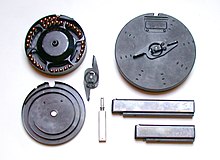
Invented by James George Accles in 1883 for use with the Gatling gun. Today, drum magazines are used primarily for light machine guns. In one type, a moving partition within a cylindrical chamber forces loose rounds into an exit slot, with the cartridges being stored parallel to the axis of rotation. After loading of the magazine, a wound spring or other mechanism forces the partition against the rounds. In all models a single staggered column is pushed by a follower through a curved path. From there the rounds enter the vertical riser either from a single or dual drums. Cylindrical designs such as rotary and drum magazines allow for larger capacity than box magazines, without growing to excessive length. The downside of a drum magazine's extra capacity is its added weight. Many drum-fed firearms can also load from conventional box magazines, such as the Soviet PPSh-41 submachine gun, RPK light machine gun and the American Thompson submachine gun.
![]() Media related to Drum magazines at Wikimedia Commons
Media related to Drum magazines at Wikimedia Commons
Saddle-drum

Before WWII the Germans developed 75-round saddle-drum magazines for use in their MG13 and MG15 machine guns. The MG34 machine guns could also use saddle-drum magazine when fitted with a special feed cover. The 75 rounds of ammunition were evenly distributed in each side of the magazine with a central feed "tower" where the ammunition is fed to the bolt. The ammunition was fed by a spring force, with rounds alternating from each side of the double drum so that the gun would not become unbalanced. The saddle-drum design was reintroduced in the late 1980s with the 100-round Beta C-Mag for use in multiple calibres, rifles, pistols and PDWs.
Helical

Helical magazines extend the drum magazine design so that rounds follow a spiral path, allowing for large ammunition capacity in a magazine that can be adapted to increase ammo capacity with only a minor increase to the dimensions of an unloaded gun (compared to a regular box magazine of similar capacity). This type of magazine is used by the Calico M960 and Bizon SMG and Long Wind CS/LS06 and KBP PP90M1.
Hopper
The hopper magazine, used in the Japanese Type 11 LMG, and a few prototype designs of the interwar period, had a fixed 'hopper' in which standard infantry rifle clips were stacked. In theory, this allowed the ammunition of riflemen and machinegunners to be interchangeable; however, problems with the reliability of the system, and the compatibility of more powerful rifle loadings with the operation of the machine gun, made this an impractical solution.[35]
STANAG magazine
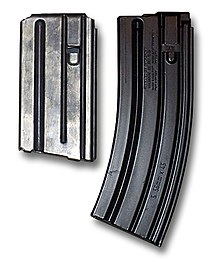
A STANAG magazine[36][37] or NATO magazine is a type of detachable magazine proposed by NATO in October 1980.[38] Shortly after NATO's acceptance of the 5.56×45mm NATO rifle cartridge, Draft Standardization Agreement (STANAG) 4179 was proposed in order to allow NATO members to easily share rifle ammunition and magazines down to the individual soldier level. The U.S. M16 rifle magazine was proposed for standardization. Many NATO members, but not all, subsequently developed or purchased rifles with the ability to accept this type of magazine. However the standard was never ratified and remains a 'Draft STANAG'.[39]
The STANAG magazine concept is only an interface, dimensional and control (magazine latch, bolt stop, etc.) requirement.[40][41] Therefore, it not only allows one type of magazine to interface with various weapon systems,[40][41] but also allows STANAG magazines to be made in various configurations and capacities.[40][41] STANAG magazines come in 20-, 30- and 40-round box magazines,[41] as well as 60- and 100-round casket magazines,[42][43] 90-round snail-drum magazines,[44] and 100-round saddle-drum magazines.[45]
High-capacity magazines
In the United States a number of federal or state laws have banned high-capacity magazines.[46] High-capacity or large-capacity magazines are generally considered to be those capable of holding more than 10 rounds, although the definitions vary.[46][47][48]
Other nations impose restrictions on magazine capacity as well. In Canada, magazines are limited to five or ten rounds, depending on the firearm.[49]
See also
References
- ^ "NRA Firearms Glossary". National Rifle Association. Archived from the original on 2011-07-18. Retrieved 2008-06-26.
- ^ a b "Gun Zone clips vs. magazines". The Gun Zone. Retrieved 2008-06-26.
- ^ "Handgunner's Glossary". Handguns Annual Magazine, 1994. Retrieved 2013-03-21.
- ^ United States Army, American Expeditionary Force (1917). Provisional Instruction on the Automatic Rifle, Model 1915 (Chauchat)., translated from the French edition, 1916
- ^ United States Ordanace Dept. (1917). Description of the Automatic Pistol, Caliber .45, Model of 1911.
- ^ United States War Dept (1907). Annual Reports of the Secretary of War.
- ^ "Magazine". SAAMI. Retrieved 2008-06-26.
- ^ "Cartridge Clip". SAAMI. Retrieved 2008-06-26.
- ^ "Firearms Glossary". National Rifle Association.
- ^ Dictionary. "Clip". Merriam Webster. Retrieved 23 July 2012.
- ^ Charles Winthrop Sawyer (1920). Firearms in American History, volume III. Cornhill Company, Boston.[page needed]
- ^ Robert D. Beeman, Ph.D. "Girandoni style air rifles and pistols - preliminary research presentation".
- ^ Military Small Arms Of The 20th Century, 7th Edition, 2000 by Ian V. Hogg & John S. Weeks, p.179-180
- ^ a b c Hugh Chisholm (1911). The Encyclopaedia Britannica: A Dictionary of Arts, Sciences, Literature and General Information. Encyclopaedia Britannica., entry for Rifle
- ^ Chamber's Encyclopaedia: A Dictionary of Universal Knowledge. W. & R. Chambers. 1891. pp. 720–721.
- ^ United States Army Ordnance Department (1898). Description and Rules for the Management of the U.S. Magazine Rifle and Carbine. p. 36.
- ^ Military Small Arms Of The 20th Century, 7th Edition, 2000 by Ian V. Hogg & John S. Weeks, p.184
- ^ Military Small Arms Of The 20th Century, 7th Edition, 2000 by Ian V. Hogg & John S. Weeks, p.180
- ^ Chuck Hawks. "The 8x50R Lebel (8mm Lebel)".
- ^ "Firearms Technical Trivia: Magazine cut-offs". Cruffler.com. February 2000.
- ^ "Modern Firearms - M14 Rifle". Retrieved 2008-06-26.
- ^ https://books.google.com/books?id=-ZqtAAAAQBAJ&printsec=frontcover&dq=The+Book+of+Gun+Trivia:+Essential+Firepower+Facts&hl=en&sa=X&ei=H_UlVbxCltigBIPdgKAB&ved=0CCcQ6AEwAA#v=onepage&q=The%20Book%20of%20Gun%20Trivia%3A%20Essential%20Firepower%20Facts&f=true The Book of Gun Trivia: Essential Firepower Facts, Gordon L Rottman, Osprey Publishing, Oct 20, 2013
- ^ "Simonov SKS carbine (USSR - Russia)".
- ^ Military Small Arms Of The 20th Century, 7th Edition, 2000 by Ian V. Hogg & John S. Weeks, p.187
- ^ U.S. patent 885,868, April 28, 1908, Improved Magazine, Inventor: Arthur W. Savage
- ^ The "follower" is the sheet metal part between the last cartridge and the spring.
- ^ Weeks, John, World War II Small Arms, London: Orbis Publishing Ltd. (1979), p. 33.
- ^ Kevin, Dockery (2007). Future Weapons. New York: Berkley Trade. ISBN 978-0-425-21750-4.
- ^ http://patft.uspto.gov/netacgi/nph-Parser?Sect1=PTO2&Sect2=HITOFF&u=%2Fnetahtml%2FPTO%2Fsearch-adv.htm&r=1&p=1&f=G&l=50&d=PTXT&S1=505419.AP.&OS=APN/505419&RS=APN/505419
- ^ a b http://bulletin.accurateshooter.com/2010/06/magpul-invents-new-quad-stack-magazine-for-ars/
- ^ Crane, David (December 3, 2010). "DR Exclusive!: SureFire MAG5-60 and MAG5-100 High Capacity Magazine (HCM) "Quad-Stack" AR Rifle Magazines: 60-Round/Shot and 100-Round/Shot AR (AR-15/M16) 5.56mm NATO Box Magazines for Significantly-Increased Firepower during Infantry Combat and Tactical Engagements of All Sorts". DefenseReview.com. Archived from the original on January 4, 2011.
{{cite web}}: Unknown parameter|deadurl=ignored (|url-status=suggested) (help) - ^ U.S. patent 502,018, Magazine Gun, Application date: April 10, 1889, Issue date: July 25, 1893, Inventor: Arthur W. Savage
- ^ http://www.cairdpublications.com/scrap/armbitguns/images/Bren%20Guns.jpg
- ^ James H. Willbanks. Machine Guns: An Illustrated History of Their Impact. p. 104.
- ^ The M16, Gordon L. Rottman, © Osprey Publishing, 2011, Page 35-36
- ^ Future Weapons, Kevin Dockery, © Penguin, 2007, Page 125-126
- ^ Watters, Daniel: "The 5.56 X 45mm Timeline: A Chronology of Development", The Gun Zone, 2000-2007.
- ^ "NATO Infantry Weapons Standardization", NDIA Conference 2008
- ^ a b c https://books.google.com/books?id=8RxJxY7wQn0C&pg=PA125&dq=stanag+magazine&hl=en&sa=X&ei=GoNKVbGeIseLoQSdoYGQAw&ved=0CCgQ6AEwAg#v=onepage&q=stanag%20magazine&f=true Future Weapons, Kevin Dockery, Penguin, 2007, page 125
- ^ a b c d https://books.google.com/books?id=-ZqtAAAAQBAJ&pg=PT147&dq=STANAG+magazine&hl=en&sa=X&ei=fX84VfHmGMHMsAWg1oDoAw&ved=0CC4Q6AEwAw#v=onepage&q=STANAG%20magazine&f=true The Book of Gun Trivia: Essential Firepower Facts. Gordon L Rottman. Osprey Publishing, Oct 20, 2013
- ^ "Magpul Invents New Quad-Stack Magazine for ARs « Daily Bulletin". Retrieved 15 November 2014.
- ^ David Crane (3 December 2010). "DR Exclusive!: SureFire MAG5-60 and MAG5-100 High Capacity Magazine (HCM) "Quad-Stack" AR Rifle Magazines: 60-Round/Shot and 100-Round/Shot AR (AR-15/M16) 5.56mm NATO Box Magazines for Significantly-Increased Firepower during Infantry Combat and Tactical Engagements of All Sorts". DefenseReview.com (DR): An online tactical technology and military defense technology magazine with particular focus on the latest and greatest tactical firearms news (tactical gun news), tactical gear news and tactical shooting news. Retrieved 15 November 2014.
- ^ http://www.defensereview.com/mwg-90-rounder-snail-drum-mag-90-rounds-of-immediate-556mm-firepower-for-your-m4m4a1-carbine-or-ar-15-carbine/ Defense Review. MWG 90-Rounder Snail Drum Magazine: 90 Rounds of Immediate 5.56mm Firepower for Your M4/M4A1 Carbine (or AR-15 Carbine) Posted by: David Crane June 21, 2009
- ^ The Gun Digest Book of the AR-15. Patrick Sweeney. Gun Digest Books, Sep 9, 2005. page 106
- ^ a b "Large Capacity Ammunition Magazines Policy Summary". smartgunlaws.org. Law Center to Prevent Gun Violence. May 31, 2013. Retrieved May 25, 2014.
- ^ Rose, Veronica (January 24, 2013). "Laws on High Capacity Magazines". cga.ct.gov. Connecticut General Assembly. Retrieved April 9, 2014.
- ^ http://www.outdoornews.com/January-2014/SAFEAct-court-ruling-dumps-7-bullet-limit/ Court Dumps Magazine Rule
- ^ "Maximum Permitted Magazine Capacity". Special Bulletin for Businesses No. 72. Royal Canadian Mounted Police. 2014-12-08. Retrieved 28 January 2015.




